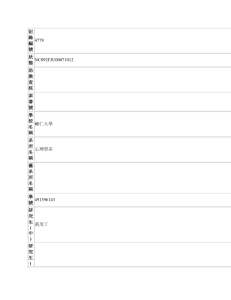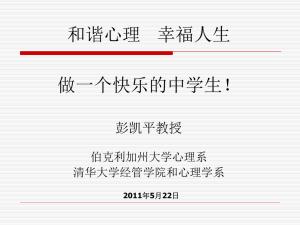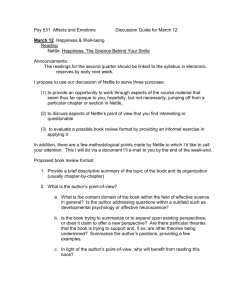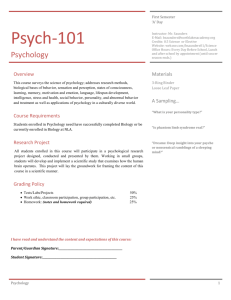記 錄 編 號 4779 狀 態 NC092FJU00071012 助 教 查 核 索 書 號 學
advertisement
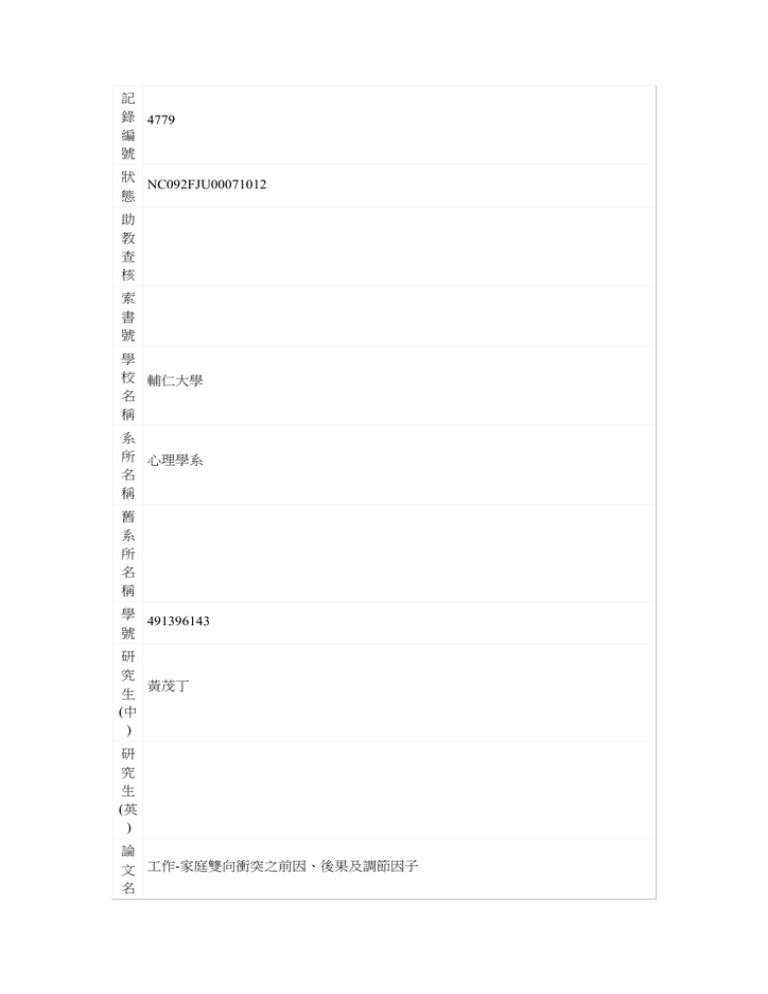
記 錄 4779 編 號 狀 NC092FJU00071012 態 助 教 查 核 索 書 號 學 校 輔仁大學 名 稱 系 所 心理學系 名 稱 舊 系 所 名 稱 學 491396143 號 研 究 黃茂丁 生 (中 ) 研 究 生 (英 ) 論 文 工作-家庭雙向衝突之前因、後果及調節因子 名 稱 (中 ) 論 文 名 稱 (英 ) 其 他 題 名 指 導 教 陸洛 博士 授 (中 ) 指 導 教 授 (英 ) 校 內 全 文 不公開 開 放 日 期 校 外 全 文 不公開 開 放 日 期 全 文 不 開 放 理 由 電 子 全 文 同意 送 交 國 圖. 國 圖 全 文 2004.07.06 開 放 日 期. 檔 案 電子全文 說 明 電 子 01 全 文 學 位 碩士 類 別 畢 業 92 學 年 度 出 版 年 語 文 中文 別 關 鍵 工作-家庭衝突 家庭-工作衝突 工作要求 家庭要求 工作滿意 家庭滿意 幸福 字 感 獨立我 互依我 (中 ) 關 鍵 work-family conflict family-work conflict work demands family demands work 字 satisfaction family satisfaction happiness independent self interdependent self (英 ) 本研究旨在瞭解工作者所感受到的「工作-家庭雙向衝突」、衝突的來源以 及衝突對個人生活適應與心理健康的影響。同時考量文化因素,瞭解其對 衝突所產生的調節作用。本研究以具有全職工作的成人為研究對象,使用 問卷法,共回收了 220 份有效問卷。 主要的研究結果發現: 1.當「工作 要求」高時,可以預測個人感受到的「工作-家庭衝突」也會高。 2.當 摘 「家庭要求」高時,可以預測個人感受到的「家庭-工作衝突」也會高。 3.當「工作-家庭衝突」高時,可以預測個人的「工作滿意」、「家庭滿 要 意」與「幸福感」會隨之降低。 4.「家庭-工作衝突」高時,「家庭滿 (中 意」會隨之降低。 5.「工作滿意」與「家庭滿意」皆能有效預測「幸福 ) 感」。 6.女性的「家庭要求」高於男性,但是男性的「家庭-工作衝突」 高於女性。 7.一般員工的「工作-家庭衝突」高於擔任主管職的人。 調節 作用部份: 1.「獨立我」在「工作要求」影響「工作-家庭衝突」的部 份,會產生具有正面意義的「緩衝作用」 2.「獨立我」在「家庭要求」 影響「家庭-工作衝突」的部份,會產生具有負面意義的「脆弱作用」 3. 「互依我」在「工作要求」影響「工作-家庭衝突」的部份,會產生具有正 面意義的「緩衝作用」。 This research aimed to understand the perceived work-family conflict (WFC), familywork conflict (FWC), their antecedences and consequences in terms of personal life adjustment and mental health. In addition, the moderating effect of individual culture was considered. Subjects with full time employment were recruited, and structured 摘 questionnaires were used for data collection. A total of 220 valid questionnaires were returned. The main findings of the study were as follows: 1. “Work demands” 要 positively predicted WFC. 2. “Family demands” positively predicted FWC. 3. (英 WFC negatively predicted “work satisfaction”, “family satisfaction” and ) “happiness”. 4. FWC negatively predicted “family satisfaction”. 5. Both “work satisfaction” and “family satisfaction” positively predicted “happiness”. 6. Females reported higher “family demands” than males, but males perceived higher FWC. 7. Non-managerial employees perceived higher WFC than managers. In addition, certain moderating effects were found: 1. “Independent self” buffered the effect of “work demands” on WFC. 2. “Independent self” exacerbated the effect of “family demands” on FWC. 3. “Interdependent self” buffered the effect of “work demands” on WFC. 論 文 目 次 目 錄............................... .І 圖目 錄............................... Ⅱ 表目 錄............................... Ⅲ 中文摘 要..............................Ⅳ 英文摘 要..............................Ⅴ 第一章 緒 論............................1 第一 節 研究動機.........................1 第 二節 研究目的.........................3 第二章 文獻探 討..........................4 第一節 壓 力與工作壓力......................4 第二節 工作-家庭衝突.....................10 第三 節 獨立我與互依我.....................22 第 四節 幸福感.........................29 第三章 研究方 法.........................42 第一節 研 究架構與研究假設...................42 第二節 研究對象........................44 第三 節 研究工具........................45 第 四節 資料分析........................50 第四章 研究結 果.........................51 第一節 樣 本描述........................51 第二節 研究變項描述性統計分析及量表信度分析..........55 第三 節 變項間的相關分析....................59 第 四節 層級式回歸分析.....................69 第五節 自我觀念的調節作用...................7 7 第五章 討 論...........................81 第一 節 研究結果概述......................81 第 二節 群體差異........................83 第三節 華人的「工作-家庭衝突」與「家庭-工作衝突」......8 4 第四節 獨立我與互依我的調節作用................ 86 第五節 研究限制與建 議.....................88 參考文 獻.............................90 附錄一............................. 103 附錄 二.............................10 7 參 考 文 獻 參考文獻 李芳如(2001):《新好男人-雙生涯家庭男性家務分擔經驗之 研究》。嘉義大學家庭教育研究所,碩士論文。 吳經熊(1992):《內心 悅樂之泉源》。台北:東大出版社。 吳璵(1991):《新譯尚書讀本》。 台北:三民書局。 韋政通(1975):《中國的智慧》。台北:牧童出版 社。 南懷瑾、徐芹庭(註釋)(1974):《周易今註今譯》。台北:臺灣 商務書局。 施建彬(1995):《幸福感來源與相關因素之探討》。高雄醫 學大學行為科學研究所,碩士論文。 張勻翔(2002):《亞里斯多德「尼 各馬科倫理學」之幸福觀-由「幸福」與諸概念的關係談起》。中央大學 哲學研究所,碩士論文。 張滿玲(譯)(1999):《社會心理學》。台 北:雙葉出版社。 傅佩榮(1994):《哲學入門》。台北:正中書局。 陸 洛(1997):〈工作壓力之歷程:理論與研究的對話〉。《中華心理衛生 學刊》(台北),10 卷,4 期,19-51。 陸洛(1998):〈中國人幸福感之 內涵、測量及相關因素探討〉。《國家科學委員會研究彙編:人文及社會 科學》(台北),8 卷,1 期,115-137。 陸洛(2003):〈人我關係界定 -「折衷自我」的現身〉。《本土心理學研究》,20 期,139-207。 黃智慧 (1991):《般若菩提心》。台北:耀文出版社。 曾慧如(1998):《個 人行為特徵對工作壓力的調節作用:以企業主管為例》。高雄醫學大學行 為科學研究所,碩士論文。 董玉娟(2000):《工作-家庭衝突、組織社會 化對離開現職傾向影響之研究:以台商派駐大陸已婚員工為例》。中山大 學企業管理研究所,博士論文。 楊國樞(1980):〈桂冠心理學叢書 序〉。台北:桂冠出版社。 證嚴(1992):《慈濟叮嚀語》。台北:慈濟 文化出版社。 Adams, G. A., King, L. A. & King, D. W. (1996). Relationships of job and family involvement, family social support, and work-family conflict with job and life satisfaction. Journal of Applied Psychology, 81, 411-420. Allen, T. D., Herst, D. E. L., Bruck, C. S. & Sutton, M. (2000). Consequences associated with work- tofamily conflict: A review and agenda for future research. Journal of Occupational Health Psychology, 5(2), 278-308. Anderson-Kulman, R. E. & Paludi, M. A. (1986). Working mothers and the family context: Predicting positive coping. Journal of Vocational Behavior, 28, 241-253. Andrews, F. M. & Withey, S. B. (1976). Social indicators of well-being. New York: Plenum. Argyle, M. (1987). The psychology of happiness. London & New York: Routedge. Argyle, M. (2001). The psychology of happiness (2nd ed.). London & New York: Routedge. Argyle, M. & Lu, L. (1990). The happiness of extraverts. Personality and Individual Differences, 11, 1011-1017. Aryee, S. (1992). Antecedents and outcomes of work-family conflict among married professional women: Evidence from Singapore. Human Relations, 45, 813-837. Aryee, S. (1993). Dual-earner couples in Singapore: An examination of work and nonwork sources of their experienced burnout. Human Relations, 46, 1441-1468. Aryee, S. & Luk, V. (1996). Work and nonwork influences on the career satisfaction of dual-earner couples. Journal of Vocational Behavior, 49, 38-52. Aryee, S., Luk, V., Leung, A. & Lo, S. (1999). Role stressors, interrole conflict, and well-being: The moderating influence of spousal support and coping behaviors among employed parents in Hong Kong. Journal of Vocational Behavior, 54, 259-278. Baron, R. M. & Kenny, D. A. (1986). The moderator-mediator variable distinction in social psychological research: Conceptual, strategic, and statistical considerations. Journal of Personality and Social Psychology, 51(6), 1173-1182. Beatty, C. A. (1996). The stress of managerial and professional women: Is the price too high? Journal of Organizational Behavior, 17, 233-251. Beutell, N. J. & Greenhaus, J. H. (1980). Some sources and consequences of interrole conflict among married women. Proceedings of the Annual Meeting of the Eastern Academy of Management, 17, 2-6. Beutell, N. J. & Greenhaus, J. H. (1983). Integration of home and non-home roles: Women’s conflict and coping behavior. Journal of Applied Psychology, 68, 43-48. Bradburn, N. M. (1969). The structure of psychological well-being. Chicago: Aldine. Bruner, J. (1990). Acts of meaning. Harvard University Press, Cambridge, MA. Burke, R. J. (1988). Some antecedents and consequences of work-family conflict. Journal of Social Behavior and Personality, 3, 287-302. Burke, R. J., Weir, T. & Duwors, R. E. (1980b). Work demands on administrators and spouse well-being. Human Relations, 33, 253-278. Butt, D. S. & Beiser, M. (1987). Successful aging: A theme for international psychology. Psychology and Aging, 2, 87-94. Campbell, A., Converse, P. E. & Rodgers, W. L. (1976). The quality of American life: Perceptions, evaluation and satisfaction. New York: Russell Sage. Campbell, A. (1981). The sense of well-being in America: Recent patterns and trends. NY: McGraw-Hill. Cantril, H. (1965). The pattern of human concerns. New Brunswick, NJ: Rutgers University Press. Carlson, D. S., Kacmar, K. M. & Williams, L. J. (2000). Construction and initial validation of a multidimensional measure of work-family conflict. Journal of Vocational Behavior, 56, 249-276. Chadwick, B. S., Albrecht, S. L., & Kunz, P. R. (1976). Marital and family role satisfaction. Journal of Marriage and the Family, 38, 431-440. Chan, K. B., Lai, G., Ko, Y. C. & Boey, K. W. (2000). Work stress among six professional groups: The Singapore experience. Social Science and Medicine, 50, 1415-1432. Chiu, R. K. (1998). Relationships among role conflicts, role satisfactions, and life satisfaction: Evidence from Hong Kong. Social Behavior and Personality, 26, 409-414. Costa, P. T. & McCrae, R. R. (1980). Influence of extraversion and neuroticism on subjective well-being: Happy and unhappy people. Journal of Personality and Social Psychology, 38, 668-678. Costa, P. T., McCrae, R. R. & Norris, A. H. (1981). Personal adjustment to aging: Longitudinal prediction from extraversion and neuroticism. Journal of Gerontology, 36, 78-85. Costa, P. T., Zonderman, A. B., & McCrae, R. R. (1985). Longitudinal course of social support among men in the Baltimore longitudinal study of aging. In I. G. Sarason & B. R. Sarason (Eds.), Social support: Theory, research and applications (pp. 137-154). Dordrecht, The Netherlands: Nijhoff. Csikszentmihalyi, M. (1975). Beyond boredom and anxiety. San Francisco: Jossey-Bass. DeNeve, K. M. & Cooper, H. (1998). The happy personality: A meta-analysis of 137 personality traits and subjective wellbeing. Psychological Bulletin, 124, 197-229. Diener, E. (1984). Subjective wellbeing. Psychological Bulletin, 95(3), 542-575. Diener, E. (1996). Subjective well- being in cross-cultural perspective. In H. Grad, A. Blanco, & J. Georgas (Eds.), Key issue in cross-cultural psychology, 319-330. Liese, The Netherlands: Swets & Zeitlinger. Diener, E. (2000). Subjective well-being: The science of happiness and a proposal for a national index. American Psychologist, 55, 34-43. Diener, E., Emmons, A., Larsen, R. J. & Griffin, S. (1985). The satisfaction with life scale: A measure of life satisfaction. Journal of Personality Assessment, 49, 71-75. Diener, E., Sandvik, E., Seidlitz, L. & Diener, M. (1993). The relationship between income and subjective well-being: Relative or absolute? Social Indicators Research, 28,195-223. Diener, E & Diener, M. (1995). Cross-cultural correlates of life satisfaction and selfesteem. Journal of Personality and Social Psychology, 68, 683-663. Diener, E, Diener, M. & Diener, C. (1995). Factors predicting the subjective well-being of nation. Journal of Personality and Social Psychology, 69, 851-864. Diener, E. & Lucas R.E. (1999). Personality and subjective well-being. In D. Kahneman, E. Diener & N. Schwarz (Eds.), Well-being: The foundation of hedonic psychology, p.p.213229. New York: Russell Sage Found. Diener, E., Sapyta J. J. & Suh, E. (1998). Subjective well-being is essential to well-being. Psychological Inquiry, 9, 33-37. Diener, E. & Suh E.M. (1998). Subjective well-being and age: An international analysis. Annual Review of Gerontology and Geriatrics, 17, 304-324. Diener, E., Suh, E. M., Lucas, R.E. & Smith, H. L. (1999). Subjective well-being: Three decades of progress. Psychological Bulletin, 125, 276-302. Diener, E. & Suh E.M. (1999). National differences in subjective well-being. In D. Kahneman, E. Diener & N. Schwarz (Eds.), Well-being: The foundation of hedonic psychology, p.p. 434-450. New York: Russell Sage Found. Diener, E. & Suh, E. M. (2000). Culture and subjective well-being. London: Cambridge. Diener, E. & Diener, B. R. (2002). Will money increase subjective well-being? A literature review and guide to needed research. Social Indicators Research, 57, 119-169. Diener, E., Oishi, S. & Lucas, R. E. (2003). Personality, culture, and subjective well-being: Emotional and cognitive evaluations of life. Annual Review of Psychology, 54, 403-425. Diener, E., Larsen, R. J., Levine, S. & Emmons, R. A. (in press). Frequency and intensity: The underlying dimensions of positive and negative affect. Journal of Personality and Social Psychology. Duxbury, L. E., Higgins, C. A. & Mills, S. (1992).After-hours telecommuting and work-family conflict: A comparative analysis. Information Systems Research, 3, 173-190. Neems, E. N. A. & Handal, P. J. (1978). Spouse’s attitudes toward maternal occupational status and effects on family climate. Journal of Community Psychology, 6, 168-172. Fordyce, M. (1986). The Psychap Inventory: A multi-item test to measure happiness and its concomitants. Social Indicators Research, 18, 1-33. Frone, M. R., Russell, M. & Cooper, M. L. (1992). Antecedents and outcomes of work-family conflict: Testing a model of the work-family interface. Journal of Applied Psychology, 77(1), 65-75. Frone, M. R., Russell, M. & Cooper, M. L. (1993). Relationship of work-family conflict, gender, and alcohol expectancies to alcohol use/abuse. Journal of Organizational Behavior, 14, 545-558. Geertz, C. (1975). On the nature of anthropological understanding. American Scientist, 63, 4753. Glenn, N. D. (1975). The contribution of marriage to the psychological wellbeing of males and females. Journal of Marriage and the Family, 37, 594-600. Greenglass, E. R. & Burke, R. J. (1988). Work and family precursors of burnout in teachers: Sex differences. Sex Roles, 18, 215-229. Greenglass, E. R., Pantony, K. L. & Burke, R. J. (1988). A gender-role perspective on role conflict, work stress, and social support. Journal of Social Behavior and Personality, 3, 317-328. Greenhaus, J. H. (1988). The intersection of work-family roles: Individual, interpersonal, and organizational issues. Journal of Social Behavior and Personality, 3, 23-44. Greenhaus, J. H. & Beutell, N. J. (1985). Sources of conflict between work and family roles. Academy of Management Review, 10(1), 76-88. Greenhaus, J. H. & Kopelman, R. E. (1981). Conflict between work and non-work roles: Implications for the career planning process. Human Resource Planning, 4(1), 1-10. Gutek, B., Searle, S. & Klepa, L. (1991). Rational versus gender role-explanations for work-family conflict. Journal of Applied Psychology, 76, 560-568. Hall, D. T. & Richter J. (1988). Balancing life and home life: What can organizations do to help? Academy of Management Executive, 11, 213-223. Haring, M. J., Stock, W. A. & Okun M. A. (1984). A research synthesis of gender and social class as correlates of subjective well- being. Human Relations, 37, 645-657. Headey, B. & Wearing, A. (1989). Personality, life events, and subjective well-being: Toward a dynamic equilibrium model. Journal of Personality and Social Psychology, 57, 731-739. Herman, J. B. & Gyllstrom, K. K. (1977). Working man and women: Inter- and intra-role conflict. Psychology of Women Quarterly, 1, 319-333. Hills, P. & Argyle, M. (1998b). Positive moods derived from leisure and their relationship to happiness and personality. Personality and Individual Differences, 25,523-535. Hinkle, L. E. (1973). The concept of stress in the biological social sciences. Stress Medicine and Man, 1, 31-48. Hofstede, G.. (1980). Culture’s consequences: International differences in work-related values. Beverly Hills, CA: Sage. Holahan, C. K. & Gilbert, L. A. (1979). Conflict between major life roles: Women and men in dual-career couples. Human Relations, 32, 451-467. Holmes, T. & Rahe, R. (1967). The social readjustment rating scale. Journal of Psychosomatic Research, 12, 213-233. Houston, J. P. (1981). The pursuit of happiness. Glenview, IL: Scott, Foresman. Inglehart, R. (1990). Culture shift in advanced industrial society. Princeton, NJ: Princeton University Press. Inglehart, R. & Klingemann, H-D. (2000). Genes, culture, democracy, and happiness. In E. Diener, & E. M. Suh (Eds.), Culture and subjective well-being, p.p.165-183. London: Cambridge. Johnson, F. (1985). The Western concept of self. In A. Marsella, G. De Vos & F. L. K. Hsu (Eds.), Culture and self. London: Tavistock. Jones, A. P. & Butler, M. C. (1980). A role transition approach to the stresses of organizationally-induced family role disruption. Journal of Marriage and the Family, 42, 367-376. Judge, T. A., Boudreau, J. W. & Bretz, R. D. (1994). Job and life attitudes of male executives. Journal of Applied Psychology, 79, 767782. Kahn, R. L., Wolfe, D., Quinn, R., Snoek, J. D. & Rosenthal, R. A. (1964). Organizational stress: Studies in role conflict and ambiguity. New York: Wiley. Kahneman D., Diener E.& Schwarz N. (1999). Well-Being: The Foundation of Hedonic Psychology. New York: Russell Sage Found. Keith, P. & Schafer, R. (1980). Role strain and depression in two-job families. Family Relations, 29, 483488. Kopelman, R. E., Greenhaus, J. H. & Connolly, T. F. (1983). A model of work, family, and interrole conflict: A construct validation study. Organizational Behavior and Human Performance, 32, 198-215. Kossek, E. E. & Ozeki, C. (1998). Workfamily conflict, policies, and the job-life satisfaction relationship: A review and directions for organizational behavior-human resources research. Journal of Applied Psychology, 83, 139-149. Kozma, A. & Stones, M. J. (1980). The measurement of happiness: Development of the Memorial University of Newfoundland Scale of Happiness(MUNSH). Journal of Gerontology, 35, 906-912. Larson, R. W. (1990). The solitary side of life: An examination of the time people spend alone from childhood to old age. Developmental Review, 10, 155-183. Lawton, M. P. (1975). The Philadelphia Geriatric Center moral scale: A revision. Journal of Gerontology, 30, 85-89. Lazarus, R. S. (1966). Psychological stress and the coping process. New York: McGraw-Hill. Lazarus, R. S. & Folkman, S. (1984). Psychological stress and the coping process. New York: Springer. Lu, L. (2001). Understanding happiness: A look into the Chinese folk psychology. Journal of Happiness Studies, 2, 407-432. Lu, L. & Shih, J. B. (1997). Personality and happiness: Is mental health a mediator? Personality and Individual Differences, 22(2), 249-256. Lu, L. & Gilmour, R. (2004a). Culture, self and ways to achieve SWB: A cross-cultural analysis. Journal of Psychology in Chinese Societies. Lu, L. & Gilmour, R. (2004b). Developing a new measure of independent and interdependent views of self. Asian Journal of Social Psychology. Lucas, R. E., Diener, E.& Suh, E. (1996). Discriminant validity of wellbeing measures. Journal of Personality and Social Psychology, 71, 616-628. Lucas, R. E., Diener, E., Grob, A., Suh, E. M. & Shao, L. (1998). Cross-cultural evidence for the fundamental features of extraversion: The case against sociability. Manuscript submitted for publication, University of Illinois at Urbana-Champaign. Markus, H. R. & Kitayama, S. (1991). Culture and the self: Implications for cognition, emotion, and motivation. Psychological Review, 98(2), 224-253. Markus, H. R. & Kitayama, S. (1994). A collective fear of the collective: Implication for selves and the theory of selves. Personality and Social Psychology Bulletin, 20, 569-579. Masuda, M. & Holmes, T. H. (1967). Magnitude estimations of social readjustments. Journal of Psychosomatic Research, 11, 219-225. Matsui, T., Ohsawa, T. & Onglatco, M. L. (1995). Work-family conflict and the stress-buffering effect of husband support and coping behavior among Japanese married working women. Journal of Vocational Behavior, 47, 178-192. Medley, M. L. (1980). Life satisfaction across four stages of adult life. International Journal of Aging and Human Development, 11, 193-209. Michalos, A. C. (1985). Multiple discrepancies theory(MDT). Social Indicators Research, 16, 347-413. Netemeyer, R.G., Boles, J. S. & McMurrian, R. (1996). Development and validation of work-family conflict and family-work conflict scales. Journal of Applied Psychology, 81(4), 400-410. Nunnally, J. (1988). Psychometric theory (2nd ed.). New York: McGraw-Hill. O’Driscoll, M. P., Ilgen, D. R.& Hildreth, K. (1992). Time devoted to job and off-job activities, interrole conflict, and affective experiences. Journal of Applied Psychology, 77, 272-279. Pleck, J., Staines, G.& Lang, L. (1980). Conflicts between work and family life. Monthly Labour Review, March, 29-32. Rim, Y. (1993). Values, happiness and family structure variables. Personality and Individual Difference, 15(5), 595-598. Rusell, R. J. H. & Wells, P. A. (1994). Predictors of happiness in married couples. Personality and Individual Difference, 17, 313-321. Ryan, R. M. & Deci, E.L. (2000). Selfdetermination theory and the facilitation of intrinsic motivation, social development, and well-being. American Psychologist, 55, 68-78. Ryan, R. M. & Deci, E.L. (2001). On happiness and human potentials: a review of research on hedonic and eudaimonic well-being. Annual Reviews of Psychology, 52, 141-166. Ryff, C. D. (1995). Psychological well-being in adult life. Current Directions in Psychological Science, 4, 99-104. Ryff, C. D. & Keyes, C. L. M. (1995). The structure of psychological well-being revisited. Journal Personality Social Psychology, 69, 719-727. Sampson, E. E. (1985). The decentralization of identity: Toward a revised concept of personal and social order. American Psychologist, 40, 1203-1211. Seligman, M. & Csikszentmihalyi, M. (2000). Positive psychology: An introduction. American Psychologist, 55, 5-14. Selye, H. (1956). The stress of life. New York: McGraw-Hill. Spector, P. E. & Jex, S. M. (1998). Development of four self-report measures of job stressors and strain: Interpersonal Conflict at Work Scale, Organizational Constraints Scale, Quantitative Workload Invertory, and Physical Symptoms Inventory. Journal of Occupational Health Psychology, 3(4), 356-367. Spreitzer, E. & Snyder, E. E. (1974). Correlates of life satisfaction among the aged. Journal of Gerontology, 29, 454-458. Suh, E M.., Diener, E., Oishi, S. & Triandis, H. C. (1998). The shifting basis of life satisfaction judgments across cultures: emotions versus norms. Journal of Personality and Social Psychology, 74, 482-493. Suh, E M., Diener, E. (2001). The role of the self in life satisfaction judgment: Weighing emotions and social information differently. Work. Pap., University of California, Irvine. Triandis, H. C. (1995). Individualism and collectivism. Boulder, Colo.: Westview Press. Veenhoven, R. (1984). Conditions of happiness. Dordrecht, The Netherlands: D. Reidel Publishing. Veenhoven, R. (1991). Is happiness relative? Social Indicators Research, 24, 1-34. Veenhoven, R. & coworkers (1994). World database of happiness: Correlates of happiness. Rotterdam: Erasmus University. Veenhoven, R. (1994a). Correlates of happiness: 7836 findings from 603 studies in 69 nations: 1911-1994. Unpublished manuscript, Erasmus University, Rotterdam, The Netherlands. Veenhoven, R. (1994b). Correlates of happiness. Rotterdam, The Netherlands: RISBO, Center for Socio-Cultural Transformation. Voydanoff, P. (1988). Work role characteristics, family structure demands, and work-family conflict. Journal of Marriage and the Family, 50, 749-761. Waterman A. S. (1981). Individualism and interdependence. American Psychologist, 36, 762-773. Waterman A. S. (1993). Two conceptions of happiness: Contrasts of personal expressiveness (eudaimonia) and hedonic enjoyment. Journal of Personality and Social Psychology, 64, 678-691. Wilson, W. (1967). Correlates of avowed happiness. Psychological Bulletin, 67,294306. Witter, R. A., Okun M. A., Stock, W. A. & Haring, M. J. (1984). Education and subjective well-being: Ameta-analysis. Education Evaluation and Policy Analysis, 6, 165-173. Wood, W., Rhodes, N. & Whelan, M. (1989). Sex differences in positive well-being: A consideration of emotional style and marital status. Psychological Bulletin, 106(2), 249-264. Yang, N., Chen, C.C., Choi, J. & Zou, Y. (2000). Sources of work-family conflict: A Sino-U.S. comparison of the effects of work and family demands. Academy of Management Journal, 41, 113-123. Yogev, S. & Brett, J. (1985). Patterns of work and family involvement among single and dual earner couples. Journal of Applied Psychology, 70(4), 754-768. 論 文 110 頁 數 附 註 全 文 點 閱 次 數 資 料 建 置 時 間 轉 檔 日 期 全 文 檔 存 取 記 錄 異 動 M admin Y2008.M7.D3 23:17 61.59.161.35 記 錄
